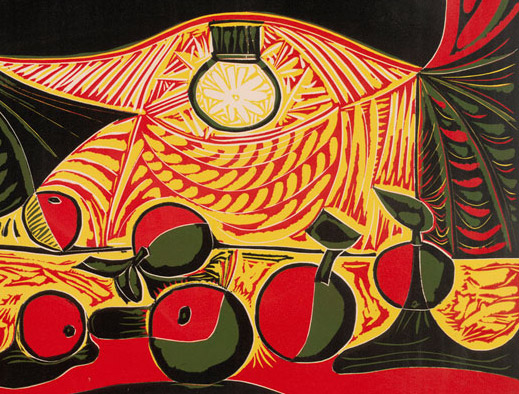Lady Lever Art Gallery
Until 8th January 2017
Reviewed by Ashley McGovern
(Image above: detail of ‘Still Life under the Lamp’ by Pablo Picasso. © Succession Picasso/DACS, London 2016. Image courtesy of Trustees of the British Museum.)
The Lady Lever Gallery’s latest exhibition, developed in close partnership with the British Museum, brings together a fascinating survey of Pablo Picasso’s work as a graphic artist using linocuts. Originally acquired by the British Museum in 2013, the three linocut series on display – Still Life under the Lamp, Jacqueline Reading, and Nude Woman at the Spring – reveal Picasso’s creative genius blossoming while he approached his late 80s.
He had tried the linocut process in 1939, and in fact over the course of his career made over 2500 prints, ranging from linocuts to etchings to lithographs. However, he quickly became bored with the laborious process of gauging out separate, perfectly aligned blocks just so they could be pressed over each other to create the final image.
By the mid-1950s he had developed the revolutionary technique of working from a single lino block, progressively cutting and scraping away at the material in up to nine different stages. There was no room for error, as once a mark had been made it was contained indelibly within the block.
Usually to see an artist’s intimate processes you would need to X-ray the image, or worse corrupt the surface to see what lies beneath. With the linocuts you can see Picasso working from stage to stage. In Jacqueline Reading, a tribute to his second wife Jacqueline Roque, he moves from a wiry surface made by scraping a comb over the lino in the first impression, to one where the gauging tool has almost completely hollowed out her face. In stark outline, only thick eyebrows, heavy lashes and Cupid’s bow lips remain intact.
His masterpiece in this field is Still Life under the Lamp, which is shown here in all nine of its reductive impressions. In the final result, the goblet on the table is heavily ornamented, the apples are brought to life with their red and green shading, and the lamp casts down feathery patterns of light. It shows Picasso’s restless approach and his view that pictorial forms can always be improved and transformed.
The final room displays Picasso’s reworking of an iconic image of the past: Edouard Manet’s Déjeuner sur l’herbe (Luncheon on the Grass). During his final years, often Picasso returned to the Old Masters and created a number of distorted homages to his favourite predecessors. In this linocut series, he isolates Manet’s half-naked young woman, who is bathing in a forest stream, and turns the scene into something far more primitive. He adds a waterfall by carving the streaming jets deeply into the lino, and the nude is given a more monumental form in the centre of the cut, like a hunched-over giant.
Throughout this series he worked in close collaboration with local printer Hidalgo Arnera, who later commented that through obsessively manipulating the single block Picasso had gained “a jumping off point from which to conquer fresh fields”. Picasso later used this design to create a sculpture of the bathing nude, and he would also create 27 paintings inspired by Manet’s controversial woodland scene.
This exhibition forms part of an exciting new season for the Lady Lever Art Gallery, which recently refurbished its South End galleries as part of a £2.8m major development project. And before the show ends in January 2017, be sure to attend the talk which will be given by Xanthe Brooke, Curator of European Fine Art, focussing on Picasso’s love of printmaking.
